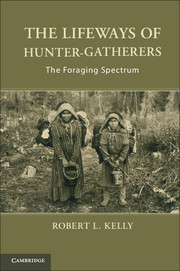Book contents
- Frontmatter
- Contents
- Tables
- Figures
- Preface
- Acknowledgments
- One Hunter-Gatherers and Anthropology
- Two Environment, Evolution, and Anthropological Theory
- Three Foraging and Subsistence
- Four Mobility
- Five Technology
- Six Sharing, Exchange, and Land Tenure
- Seven Group Size and Demography
- Eight Men, Women, and Foraging
- Nine Nonegalitarian Hunter-Gatherers
- Ten Hunter-Gatherers and Prehistory
- Notes
- References
- Index
Eight - Men, Women, and Foraging
Published online by Cambridge University Press: 05 April 2013
- Frontmatter
- Contents
- Tables
- Figures
- Preface
- Acknowledgments
- One Hunter-Gatherers and Anthropology
- Two Environment, Evolution, and Anthropological Theory
- Three Foraging and Subsistence
- Four Mobility
- Five Technology
- Six Sharing, Exchange, and Land Tenure
- Seven Group Size and Demography
- Eight Men, Women, and Foraging
- Nine Nonegalitarian Hunter-Gatherers
- Ten Hunter-Gatherers and Prehistory
- Notes
- References
- Index
Summary
Women dug roots and men ate them…men hunted rabbits and sat around.
Paiute woman (I. Kelly 1964: 132)Dreams about men are good dreams…I dream like that all the time. God really tortures me with dreams [laughs]! But when I dream that someone is making love to me, it makes me happy. It means that I have lovers and I like that…One time, Bo found out about us [Nisa and her lover]. Debe and I had gone with some other people to live in the mongongo groves for a few days. When we returned to the village, people saw us and said, “Oh, you're all already dead! Nisa, you and your friend are finished. Your husbands are going to kill you.” Because my friend was also there with her lover. My heart became miserable. I said, “If that's what's going to happen, then I’ll sit here and when my husband comes, let him just kill me.”
Nisa, a Ju/’hoan woman (Shostak 1981: 329, 331–32)You will be happy to know that Nisa's husband did not kill her. But it was from conversations such as those that the late Marjorie Shostak had with Nisa that anthropologists in the 1970s created a new model of hunter-gatherer social organization. This included bilateral (or sometimes patrilineal) kinship, bilocal postmarital residence, a sexual division of labor, egalitarian political organization, and male-female equality. As we discussed in Chapter 1, foraging society was early on defined in social terms, those of descent and residence. Although the stereotype shifted from patrilineal to bilateral descent, patrilocal to bilocal residence, male dominance to male-female equality, variability was ignored. In this chapter, we consider that variability, in the division of labor, postmarital residence, descent, and marriage. Our focus is on social organization as it entails relationships between men and women.
- Type
- Chapter
- Information
- The Lifeways of Hunter-GatherersThe Foraging Spectrum, pp. 214 - 240Publisher: Cambridge University PressPrint publication year: 2013
- 2
- Cited by

